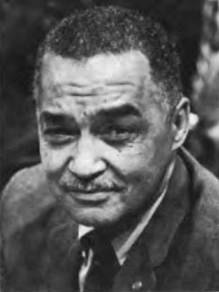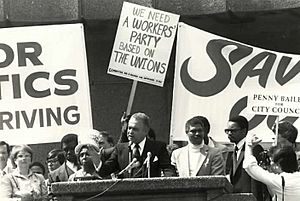Coleman Young facts for kids
Quick facts for kids
Coleman Young
|
|
|---|---|
 |
|
| 66th Mayor of Detroit | |
| In office January 1, 1974 – January 3, 1994 |
|
| Preceded by | Roman Gribbs |
| Succeeded by | Dennis Archer |
| 40th President of the United States Conference of Mayors | |
| In office 1982–1983 |
|
| Preceded by | Helen Boosalis |
| Succeeded by | Richard Fulton |
| Member of the Michigan Senate from the 4th district |
|
| In office January 1, 1965 – 1973 |
|
| Preceded by | Charles S. Blondy |
| Succeeded by | David S. Holmes, Jr. |
| Personal details | |
| Born |
Coleman Alexander Young
May 24, 1918 Tuscaloosa, Alabama, U.S. |
| Died | November 29, 1997 (aged 79) Detroit, Michigan, U.S. |
| Resting place | Elmwood Cemetery, Detroit, Michigan, U.S. |
| Political party | Democratic |
| Spouses |
Marion McClellan
(m. 1947; div. 1954)Nadine Baxter
(m. 1955; div. 1960) |
| Children | Coleman Young II |
| Profession | Politician |
| Military service | |
| Allegiance | United States of America |
| Branch/service | United States Army Air Forces |
| Years of service | 1942–1946 |
| Rank | Second Lieutenant |
| Unit | Tuskegee Airmen |
| Battles/wars | World War II |
Coleman Alexander Young (born May 24, 1918 – died November 29, 1997) was an important American politician. He was the mayor of Detroit, Michigan, for 20 years, from 1974 to 1994. He made history as Detroit's first African-American mayor.
As mayor, Young worked to improve Detroit. He supported building new places like the Joe Louis Arena. He also helped improve the city's public transportation. He worked with big companies like General Motors to build new factories. Young received the Spingarn Medal in 1981 from the NAACP for his achievements.
Contents
Early Life and Education
Coleman Young was born in Tuscaloosa, Alabama. His father, William Coleman Young, was a dry cleaner, and his mother was Ida Reese Jones. In 1923, his family moved to Detroit. This was part of the Great Migration, when many African Americans moved from the South to industrial cities for better chances.
Young graduated from Eastern High School in 1935. He became a member of the United Auto Workers union. He worked for Ford Motor Company and later for the United States Post Office Department.
Serving in World War II
During World War II, Young served in the United States Army Air Forces. He was a second lieutenant, a bombardier, and a navigator. He was part of the famous Tuskegee Airmen, a group of African-American military pilots.
In 1945, Young was involved in the Freeman Field mutiny. This was when 162 African-American officers were arrested. They were protesting against unfair segregation rules at a military base.
Fighting for Civil Rights
In the 1940s, Young was active in groups that worked for workers' rights. He spoke out against racial segregation in the Army. He also fought against unfair treatment in the UAW union.
In 1952, Young appeared before a powerful government committee called the HUAC. This committee was known for investigating people suspected of being communists. Young bravely stood up to the congressmen. He refused to answer if he was a member of the Communist Party. He instead spoke about the unfair treatment of African Americans.
He told a congressman from Georgia: "I happen to know, in Georgia, Negro people are prevented from voting by virtue of terror, intimidation and lynchings." His strong stand made him a hero in Detroit's growing black community.
Political Career
Young built his political support in Detroit during the 1940s and 1950s. This area was becoming a center for the African-American community. In 1960, he was chosen to help write a new state constitution for Michigan.
In 1964, Young was elected to the Michigan State Senate. He helped pass a law that required fair talks to settle disagreements between public worker unions and cities. He also pointed out that rural areas received more state money for bus service than Detroit.
Becoming Mayor of Detroit
The 1973 Election
Coleman Young decided to run for mayor of Detroit in 1973. A big part of his campaign was to stop police violence against black residents. At that time, nearly half of Detroit's population was black. However, the police department was mostly white.
Young spoke out against a police unit called STRESS (Stop the Robberies and Enjoy Safe Streets). This unit was accused of killing 22 people and arresting many without good reason. Young promised to get rid of STRESS if he became mayor. The police department supported John Nichols, the Police Commissioner, who was running against Young.
The election was very close. Young won, becoming Detroit's first black mayor. His victory was a major moment in the city's history. In his first speech, Mayor Young said that the city had been divided by race for too long. He said, "What is good for the black people of this city is good for the white people of this city." He wanted everyone to work together.
Young served five terms as mayor, from 1974 to 1994. He won re-election easily in 1977, 1981, 1985, and 1989. He was mayor for a total of 20 years.
First Term: 1974–1978
As mayor, Young quickly disbanded the STRESS police unit. He worked to make the police department more diverse. He also started community policing, where officers worked closely with neighborhoods. These changes helped reduce complaints about police brutality.
Young said that a high point of his first term was preventing a riot. This happened after a black teenager was shot. He praised the police for acting professionally and community leaders for helping keep the peace.
Second Term: 1978–1982
In his second term, Young focused on affirmative action. This meant making sure that city jobs, especially in the police department, included more minorities and women. He called Detroit "the Affirmative Action City."
However, a budget crisis in 1981 caused problems. Young had to convince voters to approve a tax increase. He also had to get city workers to agree to a wage freeze.
Third Term: 1982–1986
Young's third term dealt with the challenges of racism between the city and its surrounding suburbs. He understood that the city and suburbs needed to work together to grow. He tried to attract more jobs to Detroit to build stronger partnerships.
From 1982 to 1983, Young was the president of the United States Conference of Mayors.
Fourth Term: 1986–1990
During his fourth term, Young continued to improve race relations and neighborhoods. He worked on projects to build new apartment units. These projects aimed to bring people of different backgrounds together.
Detroit's population dropped a lot during his time as mayor. Young worked to rebuild neighborhoods and make the city better. He believed that creating jobs and economic growth would help Detroit's communities.
Fifth Term: 1990–1994
In his final term, there were strong opinions about Young's response to the death of Malice Green. Green was a young Black man who died after being beaten by two white police officers in 1992. This happened shortly after the Los Angeles riots, which protested police actions.
Young's Legacy and Achievements
One of Young's biggest achievements was making the police department more diverse. He also led many economic development projects across the city. He successfully managed two financial crises.
Young left a lasting mark on Detroit. During his time as mayor, many large construction projects were completed. These included the Renaissance Center, the Detroit People Mover, and the restoration of the Fox Theater.
Personal Life
Coleman Young was married and divorced twice. He had a son, Coleman Young II, with Annivory Calvert.
Young was a Prince Hall Freemason. He passed away in 1997 from emphysema. After his death, former President Jimmy Carter called Young "one of the greatest mayors our country has known." Michigan Governor John Engler said Young was "a man of his word" who worked to help Detroit.
Assessment
Investigations
There were several federal investigations into Young's administration. Some of his associates were found guilty of crimes, but Young himself was never charged.
In 2000, documents showed that the FBI watched Young for many years. This started in the 1940s because they thought he might be linked to communists. Even with all the investigations, Young was never found guilty of any wrongdoing.
Economic Challenges
Young's time as mayor happened during a period of economic challenges in the U.S. This included recessions and a decline in manufacturing jobs. Some people blamed Young for these problems. However, his supporters said that other factors were at play. These included people moving out of the city and changes in the car industry.
Police Department Changes
Young believed that changing the police department was one of his greatest successes. He started programs to make the police force more diverse. He also created Neighborhood City Halls and Police Mini Stations to connect with communities. Young used community policing to organize large groups of citizens to help prevent arson on Devil's Night each year.
Quotes
Coleman Young was known for speaking his mind. Here are some of his famous quotes:
On trying to enroll in a Catholic high school:
A brother in the order asked if I was Hawaiian. I told him, 'No, Brother, I'm colored.' He tore up the application form right in front of my nose. I'll never forget it. It was my first real jolt about what it means to be black. That was the end of me and the Catholic Church.
On how he wanted to be remembered:
I suppose I'd like to be remembered as the mayor who served in a period of ongoing crisis and took some important steps to keep the city together, but left office with his work incomplete.
Legacy
- Young is buried at Elmwood Cemetery in Detroit.
- The City-County Building in Detroit was renamed the Coleman A. Young Municipal Building in 1999.
- Young helped get the money for the Charles H. Wright Museum of African American History. A part of the museum is named after him.
- Detroit City Airport was renamed Coleman A. Young International Airport.
- In 1979, Young received the U.S. Senator John Heinz Award for Public Service.
- In 2022, the Michigan Legislature decided to replace a statue in the National Statuary Hall Collection with a statue of Young.
Images for kids
See also
 In Spanish: Coleman Young para niños
In Spanish: Coleman Young para niños
- Executive Order 9981
- List of mayors of Detroit
- List of Tuskegee Airmen
- Military history of African Americans
- Tuskegee Airmen



